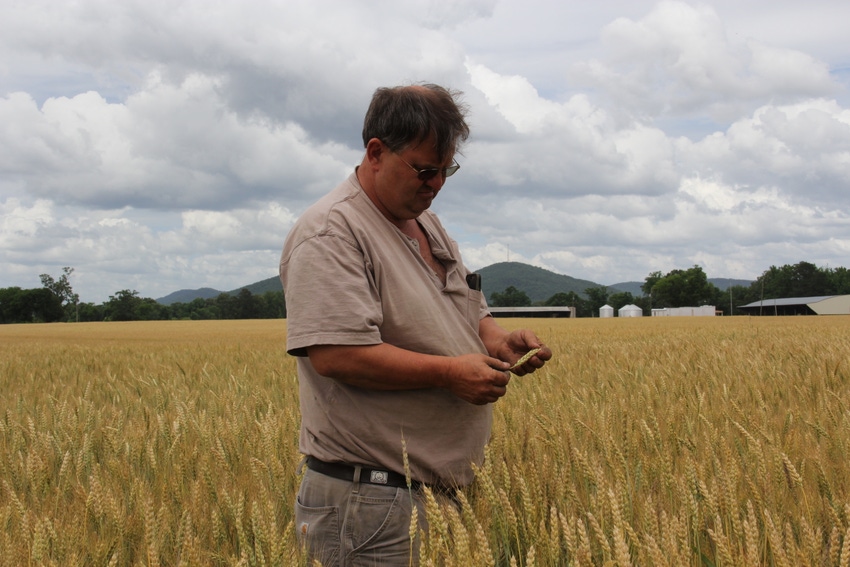October 23, 2018

Dr. Regan Nolan, University of Georgia Extension grains specialist, has announced that Cherokee County Ala., farmer Nick McMichen is the winner of this year’s Georgia wheat yield contest.
McMichen, who bought the farm with two other Alabama growers in the winding Coosa River area of neighboring Floyd County, Ga., three years ago, had an eye-popping yield of 129 bushels per acre. McMichen, who farms along with his father, Randall; son-in-law Tyler Bruce; and son Matt, said it was a family effort.
McMichen said they were blessed with sunny weather and moderate temperatures in April and May thereby increasing the photosynthetic production of the plants and decreasing disease. They also had ideal conditions for harvest. The loamy well-drained bottom land was another factor in their high yields. “The weather is out of my control, “he said, “but I haven’t been satisfied with my wheat yields in the past and knew I had to make some changes.”
McMichen attended an Alabama Extension wheat production meeting in Centre last fall where former University of Georgia Extension grain specialist Dr. Dewey Lee spoke. McMichen said the meeting was an eye opener for him. He noted, “I wasn’t planting deep enough and putting out too much nitrogen. It was the little details I followed in the Alabama Extension wheat audit and trying to do things on a timely basis that really helped improve my yields and, more importantly, my profitability. I was able to not only increase my yields by following the wheat audit, but also reduce my input costs by using less nitrogen.”
Dr. Lee applauded McMichen for his state winning yield, noting it was only six bushels off the Georgia record wheat yield of 135 bushels per acre set in Grady County.
Lee observed: “Nick saw the small changes he made in his management practices do not cost him very much, but pay huge dividends. This gave him the opportunity to take advantage of the good weather he had this spring to make high yields.”
Keith Mickler, Floyd County Extension coordinator and agricultural agent, certified the yield at harvest and commented, “Nick’s high yield is a noteworthy accomplishment for Floyd County and for agriculture in Georgia.”
McMichen planted Pioneer 26R41 at 1.3 million seed per acre in the middle of the optimum planting date for wheat in north Alabama on Oct. 31. He treated his seed with an insecticide to help control aphids and prevent barley yellow dwarf virus which they transmit. Insecticide seed treatments for control of aphids are more likely to pay off in north Alabama than in south Alabama.
McMichen grid sampled in 2016 and applied lime at a variable rate. He applied two and a half tons of chicken litter pre-plant and top-dressed with 60 pounds of nitrogen using 28-0-0-5. He normally would have made another application of nitrogen, but decided to follow the Alabama audit and tissue sample.
McMichen explained: “The tissue sample confirmed I had adequate nitrogen. My wheat would have lodged if I had applied any additional nitrogen. I was also able to harvest timely by not over-applying nitrogen. The tissue sample also showed I was deficient in boron. I applied a quart per acre of 10 percent boron twice with my fungicide applications to correct it.”
As an Extension agent, I worked with several high yield wheat growers this past growing season and boron was also deficient in their tissue samples. Boron is important in wheat pollination and grain set. A deficiency of boron can cause pollination problems and poor grain set.
McMichen used a new herbicide, Quelex, on his wheat and was extremely pleased. “I had the best weed control I have ever had especially on henbit,” he exclaimed. He applied tebuconazole plus an insecticide at flag leaf and followed up with Prosaro at early flowering for protection against Fusarium head scab.
McMichen says, “The results speak for themselves. Gathering 100 plus bushel wheat will spoil you when you see it flooding into the combine. I had a variety that didn’t perform as well as Pioneer 26R41, but over my entire wheat crop of 400 acres I averaged 94 bushels per acre and am very pleased with that yield.” McMichen also had a private company put in a variety trial on his farm and the varieties in the trial averaged from 101 to 127 bushels per acre.
The rebound in prices have made wheat a more attractive option. McMichen sold his crop for $5.20 per bushel along with $160 of wheat straw per acre.
McMichen noted: “Another advantage of baling the straw was a cleaner bed to plant my crops behind the wheat.” He planted cotton and soybeans behind his wheat and we will do a budget analysis of the profitability of each crop after harvest.
He accounted for the nutrients removed with the wheat straw based on an analysis of his straw. He removed 9.5 pounds of nitrogen, 6.5 pounds of phosphorus and 60 pounds of potassium per acre with the straw or about $23 per acre of nutrient removal.
His returns above variable costs for his average yield of 94 bushels per acre was $357.63 per acre and a whopping $522.13 on his high yielding Pioneer 26R41.
About the Author(s)
You May Also Like




